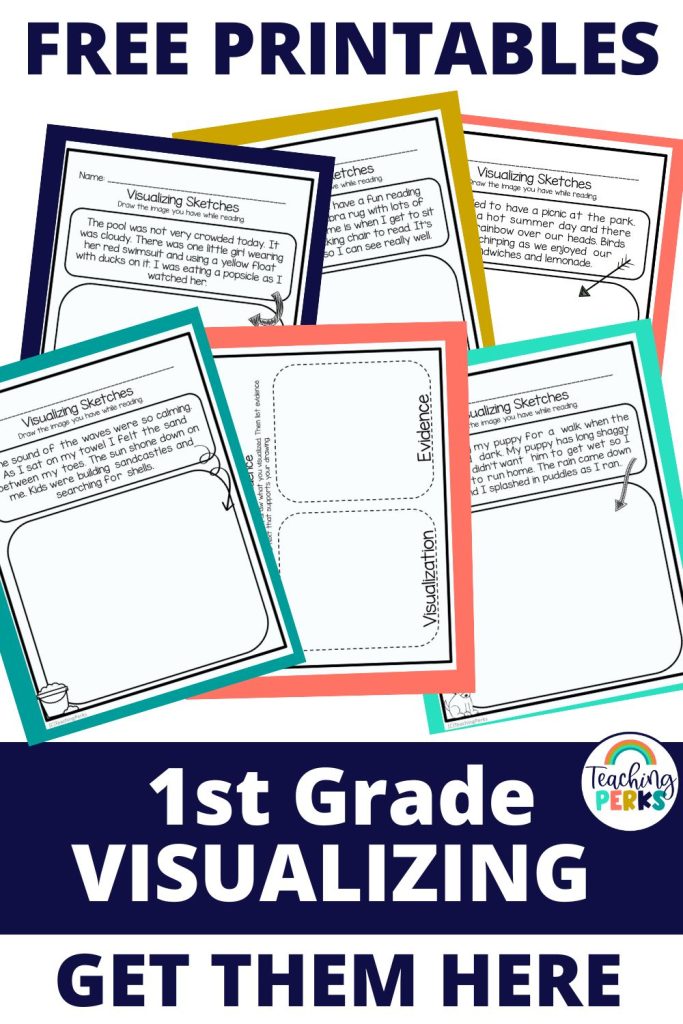In 1st Grade, one of the most important things we teach our students is how to build a strong foundation for reading. We need our students to not only be able to read, but to understand what exactly they are reading. This is where reading comprehension skills come in. While there are many different ways to practice and establish reading comprehension such as retelling and finding the main idea and key details, teaching visualizing for comprehension is a huge strategy for first graders.


What is Visualizing in Reading Comprehension?
When you think about the word visualizing, there are usually pictures involved. If I were to ask you to tell me about your favorite vacation, a picture comes to mind and you use that picture and your memories to tell me about that vacation. If I were to ask you about your favorite book, you also probably have images in your head that your mind created to help you understand that book better. This is the skill we are encouraging in our young readers. We want them to be able to paint a mental picture while they are reading and use visualizing for comprehension in their reading.

Visualizing for comprehension is only one reading strategy of many different ones you may want to try with your first graders. For a more comprehensive list, check out this article: Reading Strategies for Comprehension: 15 Strategies You Must Teach Students to Master.

3 Fun Ways to teach Visualizing for Comprehension in 1st Grade
- Read a picture book without allowing your students to see the pictures. Ask students what they pictured in their minds while you were reading, some may have visualized the story without even thinking about it.
- Use different types of questions like who, what, when, where, and why to encourage students to use their imaginations to visualize. The more prior knowledge and details they associate with a story, the better their visualization skills will be and the greater chance of comprehension.
- Read mentor texts with descriptive language and ask your students to illustrate the story. This activity encourages your students to make their own visualizations as they draw what they see in their mind as you read.

For more ideas on helping your students to become reading comprehension masters, I have a resource built just for you. My options for Reading Mini-Lessons include reading skills bundles as well as reading comprehension mini-lessons catered to 1st, 2nd, and 3rd grade common core standards that you can use in small groups or with the whole class.
Struggles with Visualizing that 1st Graders May Have
Visualizing for comprehension can be difficult in 1st grade. Students are easily distracted and may have difficulty listening to the story if there are no pictures. Go slowly and do one page at a time, ask for volunteers to share what they picture after each chunk of text that you read. Encourage their creativity and make sure you are asking questions to help them visualize better. Provide sentence stems or ask questions like who, what, when, where, why, and how to really develop what is happening in the story you’re reading and what that may look like. It may be helpful to take notes together on the board or draw a picture together as a class as to what visualization of a text may look like.
After you have given an example of what visualization might look like together as a class, ask volunteers to retell the story. Retelling is a great way to ensure that your students are comprehending what they are reading. For a free activity and lesson plan on retelling delivered straight to your email, click HERE. I also included a fantastic book list suggestion for teaching this skill.

Encouraging Independent Practice in Visualizing
Visualizing for comprehension in younger students is an important step in building a foundation of reading comprehension. In addition to incorporating the visualizing strategy in your lesson plans, encourage your students to use their reading comprehension whenever they are reading at school or at home. You can print posters or bookmarks to remind them of the strategies they can use which can be taken home and practiced with parents. Grab this set of free printables for students to practice visualizing at home or at school. These are great to send home for extra practice!
Retelling is a great skill that can be practiced at school or at home with the aid of visualization. Encourage your students to demonstrate their visualization in their reading at school and at home by asking themselves questions about what the scene in their story may look like in real life. In your class newsletter or home page, include a link to my article on Retelling of a Story: 3 Tips Guaranteed to Boost Comprehension so parents can help at home, too.
For reading comprehension practice, try some of these great lesson ideas I have available with Interactive Read Alouds. There are lots of fun readers and activities to encourage reading comprehension that your students will love.

You May Also Like
Retelling of a Story: 3 Tips Guaranteed to Boost Comprehension
Reading Strategies for Comprehension: 15 Strategies You Must Teach Students to Master
Sharing is caring the say, and you’ve done a fantastic job in sharing your knowledge on your blog. It would be great if you check out my page, too, at UY4 about Thai-Massage.
This is quality work regarding the topic! I guess I’ll have to bookmark this page. See my website QH3 for content about Cosmetics and I hope it gets your seal of approval, too!